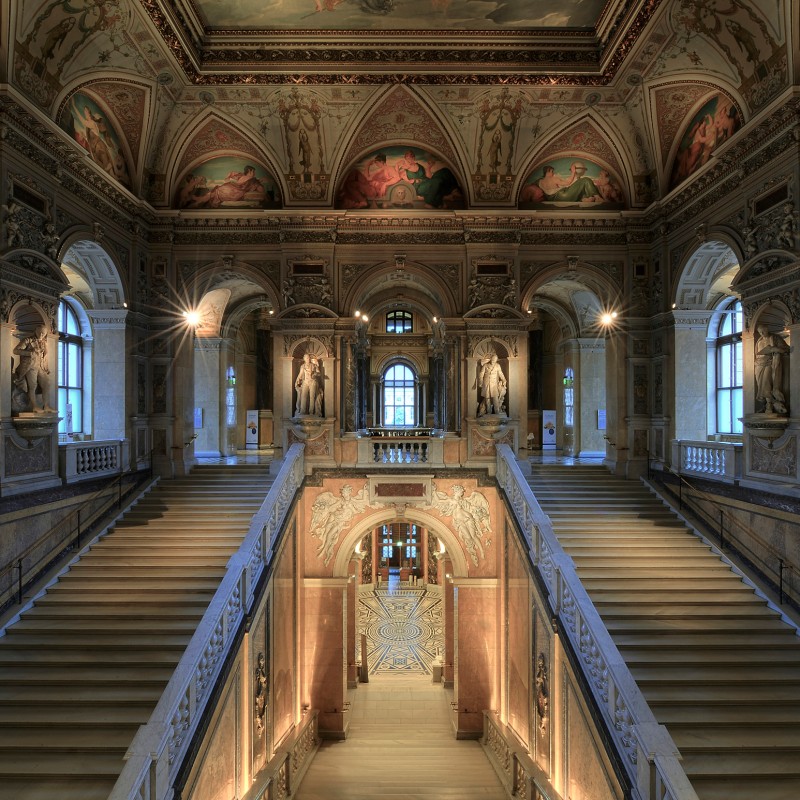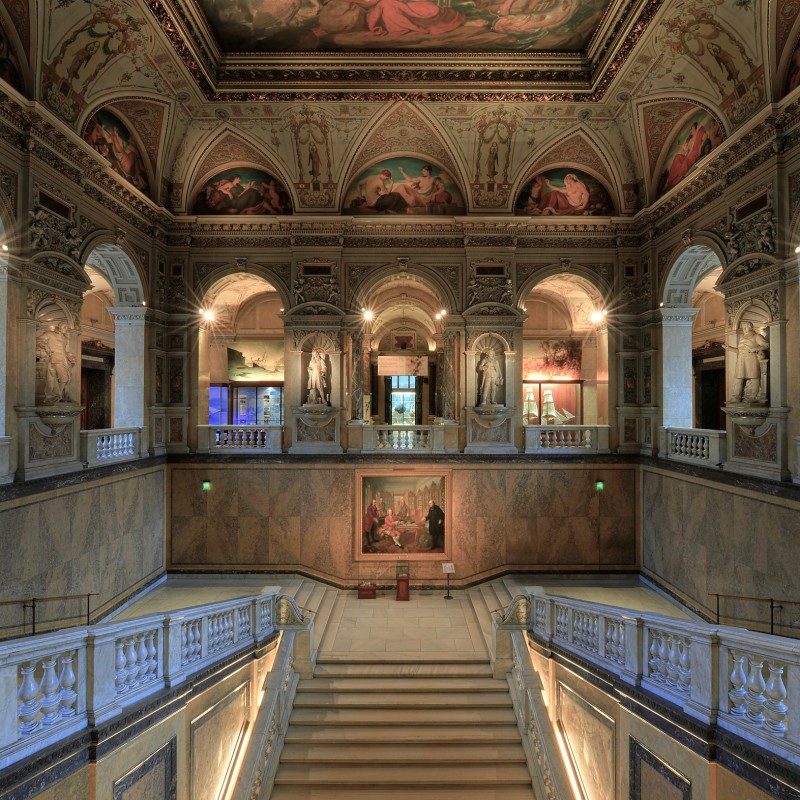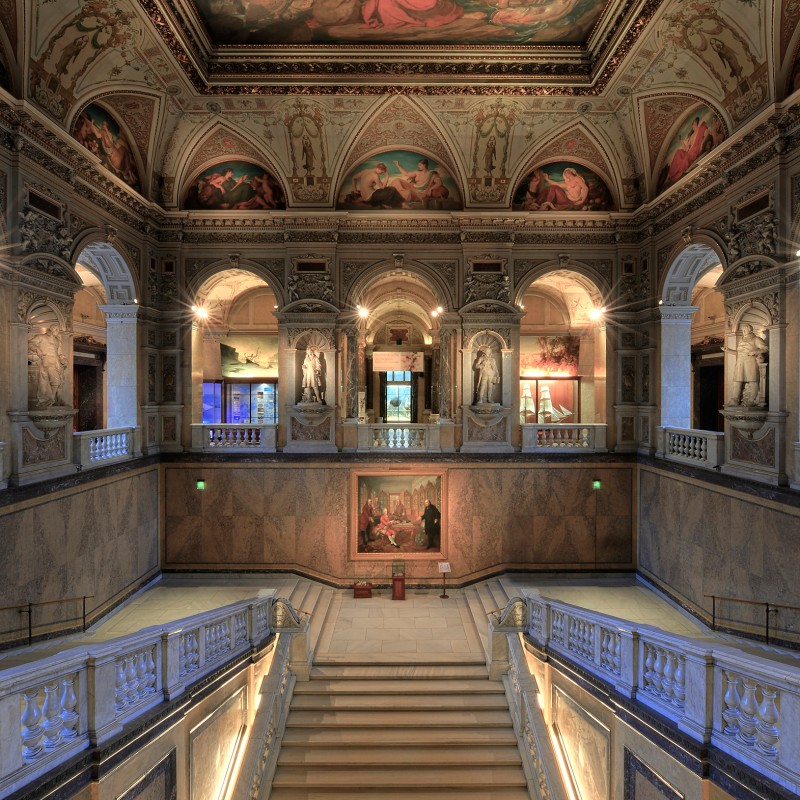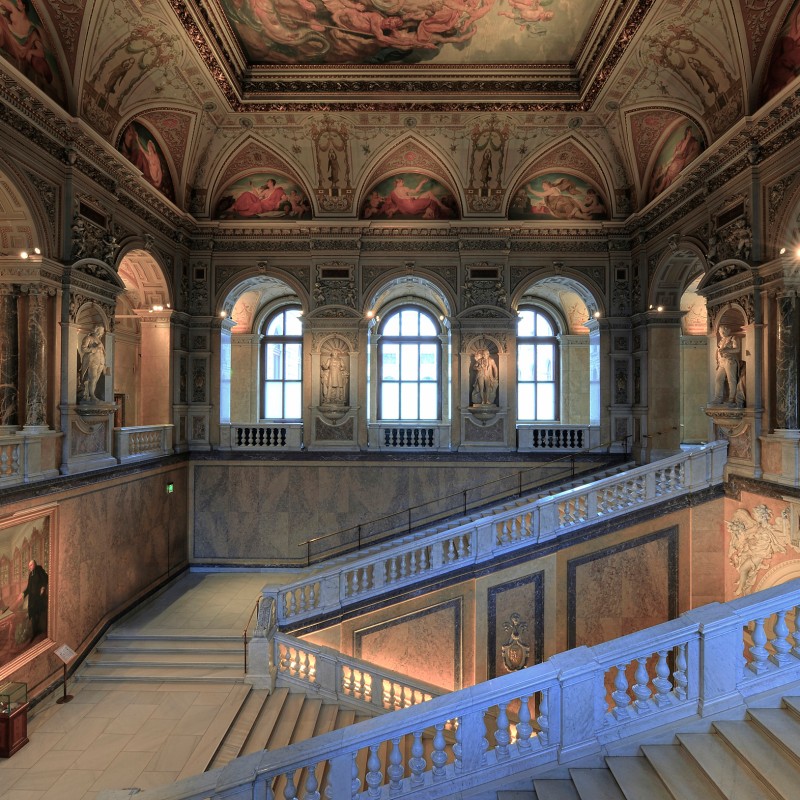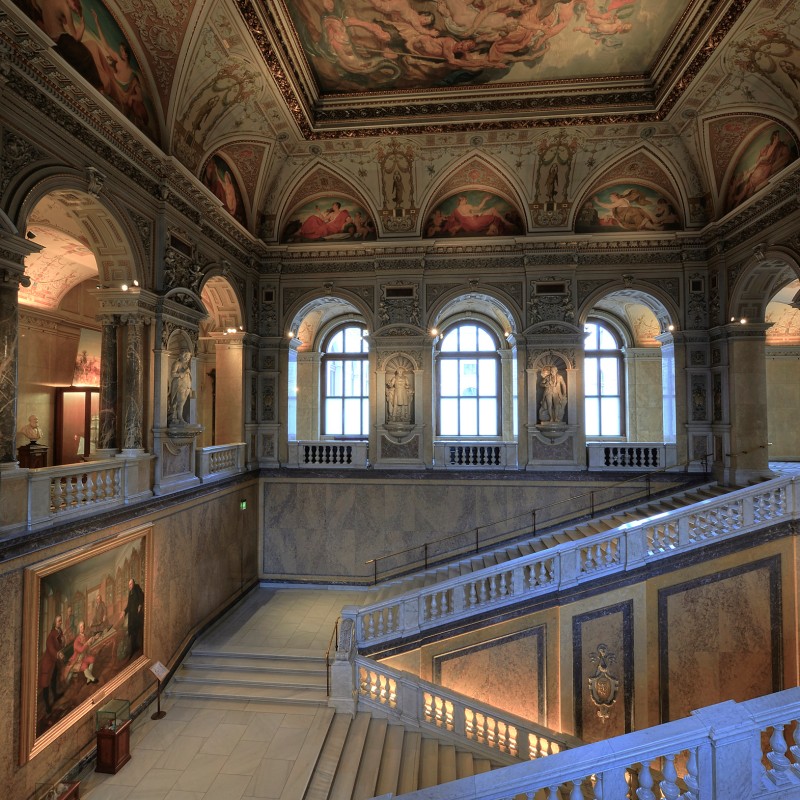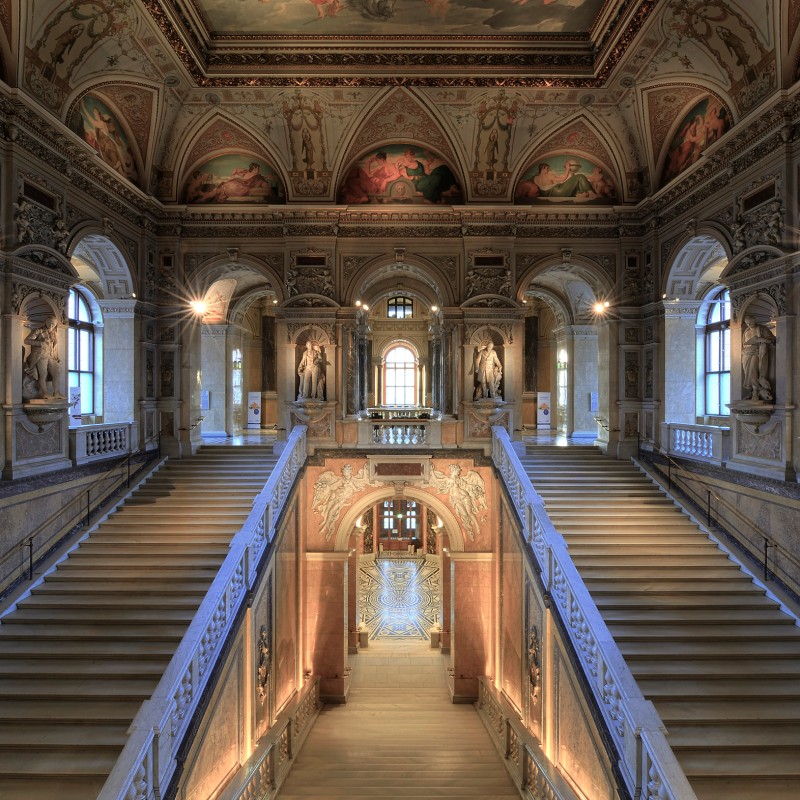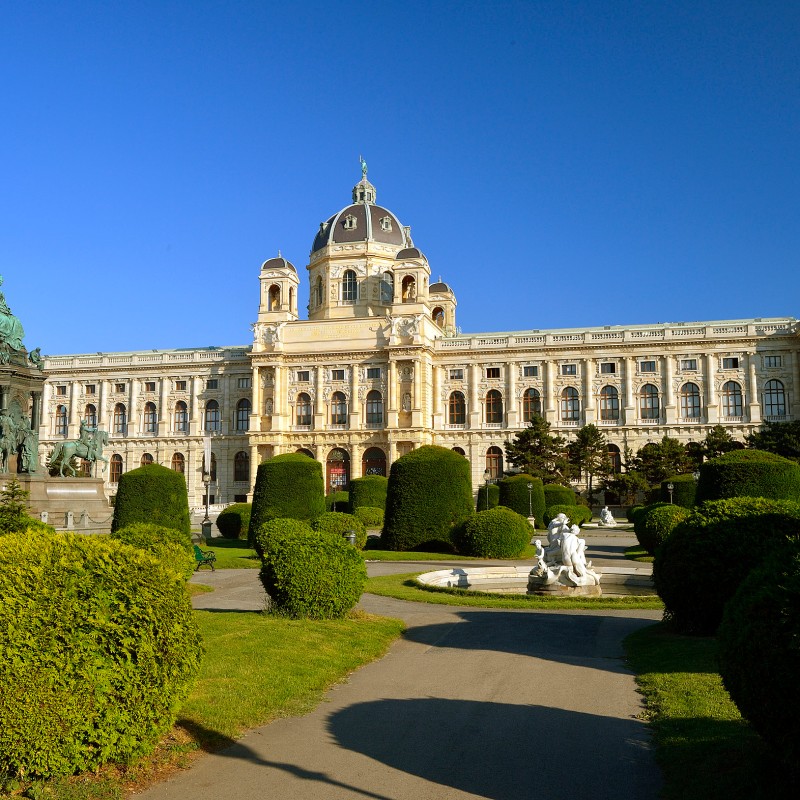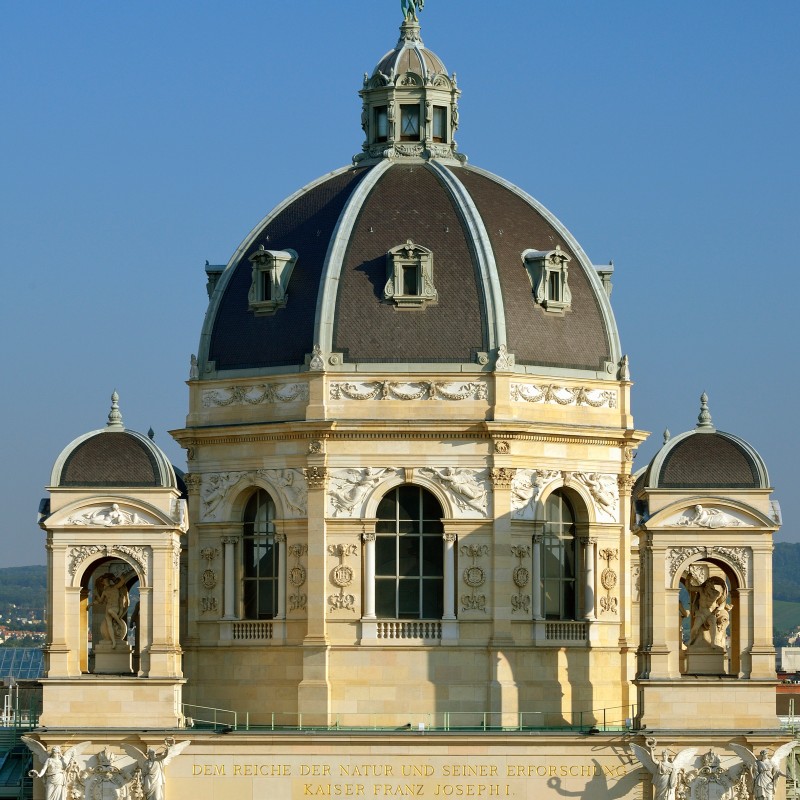Museum
The Natural History Museum Vienna is one of the most important natural history museums
in the world. Its earliest collections are more than 250 years old.
The Natural History Museum Vienna is one of the
most important natural history museums in the world. Its earliest collections are more than 250 years old. Today around 30
million objects are kept there.
This collection, which is constantly growing, has been housed since 1889 in a mighty “palace of natural sciences” on the Ringstraße road running around Vienna city center. The combination of the architecture, sculptures, paintings, furniture, and valuable exhibits make the museum a rare gem of great cultural importance.
Famous, irreplaceable objects include the Venus of Willendorf (around 29,500 years old), the Steller’s sea cow (which became extinct more than 200 years ago), huge dinosaur skeletons as well as the world’s largest and oldest meteorite collection on display. These and the many other items are shown in 39 large exhibition halls.
The most eye-catching exhibits of historic-cultural importance are listed in the NHM TOP 100 catalogue, which is available in the museum shop and contains detailed descriptions of the objects as well as photos by Lois Lammerhuber.
Mezzanine
Department of Mineralogy and Petrography (Halls 1-5)
The collections of the Department of Mineralogy and Petrography are among the most important worldwide, first and foremost thanks to their outstanding alpine minerals and other material from the territory once ruled over by the Austro-Hungarian monarchy. The systematically categorized mineral collection is at the heart of the items on display, which also include minerals from Austria, building and decorative stones, mining and smelting products, a rock collection as well as a number of precious stones. Highlights include Columbian emeralds, large gold and platinum nuggets, diamonds, the largest opal in Europe, and a topaz weighing 117 kg.
Meteorite Collection (Hall 5)
The collecting of meteorites started shortly after the imperial “cabinet of natural sciences” was first created back in 1748. Therefore, the meteorite collection at the Natural History Museum Vienna is the oldest of its kind in the world. Hall 5 contains the largest display of meteorites anywhere in the world. The hall was redesigned in 2012 and today combines outstanding exhibits, learning stations, interactive elements, and animations explaining the history and science behind these important objects and underlining the fact that meteorites are much more than just rocks that fall from the sky. Meteorite strikes are shown using a 3D animation, while the hands-on Impact Simulator shows what would happen if a large meteorite or asteroid hit Vienna. Further highlights include a screen triptych all about the formation of the solar system as well as a recently restored “planet machine” (an orrery) from 1753 made by Johann Georg Neßtfell im top-100 buch steht Nestfell.
Department of Geology and Paleontology (Halls 6-9)
This section of the collection focuses on the development of life throughout the history of Planet Earth. Starting with the simplest of life-forms, which are similar to modern-day algae and were responsible for creating oxygen in the atmosphere, the exhibition takes visitors on a journey through time covering more than 4 billion years and highlights important developments in the evolutionary chain using outstanding exhibits and reconstructions. Accompanying the exhibition is the book “100 Steps in Earth’s History” with texts explaining how Planet Earth has changed and providing much more information on the objects presented than a usual guide book.
Hall 6: The redesigned “Emperor’s Hall” was reopened on August 10, 2009 to mark the 120th anniversary of the NHM Vienna’s foundation and is dedicated to Planet Earth. It focuses mainly on the "Gaia-sphere" (named after the Greek goddess of the Earth) comprising the lithosphere (the Earth’s solid rock shell), the atmosphere (its gaseous envelope), the hydrosphere (the water in the oceans, rivers, and lakes), as well as the biosphere (the part of the Earth home to living beings). The interactions between geological forces, climate, and life have shaped our planet for more than 4 billion years.
Interactive stations and impressive animations educate and inform visitors on their journey through time, including a visualization of how our planet was formed as well as a separate exhibit showing the 2000-year journey of a water droplet as it makes its way through the world’s oceans. Using the “volcano pump” visitors can pump up the pressure in a magma chamber and create their own volcano eruption. A model of the Earth measuring two meters in size gives a fascinating view of our planet similar to that enjoyed by astronauts orbiting high above.
Hall 7 is all about the early history of Earth (Precambrian) and the following Paleozoic as well as the life forms which existed at the time, in particular the first multicellular organisms of the Ediacara biota and the bizarre Burgess animals. Most representatives of both groups have no surviving modern-day relatives and are therefore hard for us to imagine, though detailed reconstructions are provided to help visitors understand what these creatures would have looked like. Further highlights include a reconstruction of a carbon forest buzzing with giant dragonflies as well as a diorama showing a 420-million-year-old reef from Gotland during the Silurian period. One of the most popular attractions is the “time machine” enabling visitors to embark on a virtual journey through time, watch as the continents move and even look into the future.
Hall 8 is dedicated to the Mesozoic – the time when dinosaurs roamed the Earth and one of the most exciting periods in the history of our planet. The exhibits are just as diverse as the creatures at this time, ranging from dinosaur skeletons and fossils of ancient birds to huge ammonites, sea lilies, ammonites, petrified coral reefs, and the remains of the first flowering plants. Among the most popular attractions are the highly realistic reconstructions of hairy flying dinosaurs. Fittingly, the exhibition concludes with a simulated meteorite strike similar to that which is believed to have marked the end of the Mesozoic.
Hall 9 presents the Cenozoic, the most recent period in Earth’s history, which began around 65 million years ago. Exhibits include a number of highly exotic plants and animal fossils, some of which will be familiar to visitors, found in the area around Vienna. Among the highlights are a complete skeleton of a 17-million-year-old Prodeinotherium elephant, an enormous fossilized palm leaf, three evolutionary steps of the horse (including a pygmy horse found in the Messel Pit in Germany), numerous amber fossils, the huge limbs of the Chalicotherium as well as a diorama showing what a coral reef may have looked like 16 million years ago. A “horse machine” animation enables visitors to trace the development of the modern horse from a dog-sized forest dweller living off leaves to the grass-eating steppe animal we are more familiar with today.
Dinosaur Collection (Hall 10)
There is no group of fossils as popular as the dinosaurs. More than 1,000 different species of dinosaur have been discovered so far, among them the largest animals to have ever lived on Planet Earth. Dinosaurs, pterosaurs, and ichthyosaurs ruled the land, air, and oceans respectively during the Mesozoic. Therefore, it should come as no surprise that this collection is among the most visited attractions at the Natural History Museum.
The main architectural feature is the central podium giving visitors a 360° view of the large skeletons of Diplodocus, Allosaurus, and Iguanodon. It is brought to life by an animatronics model of an Allosaurus, the most dangerous predator of the Late Jurassic. Measuring over 6 meters in length, this highly realistic moving model is the size of a young allosaurus. Adjacent to it stands the skeleton cast of a 150-million-year-old Allosaurus fragilis from Utah. Cruising above visitors’ heads is a lifesize model of a Pteranodon with a wingspan of 7 meters. Further highlights include several pterosaur skeletons, a female ichthyosaur complete with preserved embryos, and the skeleton of Archelon ischyros, the biggest tortoise to have ever lived.
Intricate computer animations bring the skeletons and fossils “back to life” and provide a fascinating insight into where and how many extinct species lived.
The most important steps in the development of dinosaurs and related reptiles are also presented. One of these important steps, which was essential for reptiles to flourish as they did, was the evolution of the egg. This protected the embryo and gave it the nutrients it needed, therefore meaning it required no external water. Feathers are another major focus of the exhibition. Many dinosaurs had feathers, which experts believe developed at different times and independently from species to species. The lifesize model of a feathered Deinonychus shows how much our ideas of these reptiles have changed. Today we know that modern-day birds are descended from a certain group of dinosaurs who lived during the Jurassic Period, so you could say that the hummingbird is in some ways a tiny dinosaur.
Ice Age Collection (corridors of the mezzanine)
The main focus of this section of the exhibition is mankind as an integral part of nature – be it as a product of evolution or as a (sometimes too) successful predator that for millennia has caused or accelerated the extinction of many organisms. Humans are also shown in relation to climate changes. For thousands of years, climatic fluctuations on Planet Earth have shaped the development of civilizations, from the earliest advanced cultures in Egypt and Mesopotamia to the outbreak of the French Revolution. Today we appear to be experiencing the first period in the history of humans during which we ourselves have influenced our climate. Global warming and its consequences are addressed. Dramatic time-lapse pictures show just how much glaciers have melted, while stereo images illustrate how warmth-loving insects are set to be the winners of global warming.
A station showing the development of the climate over the last 700 million years underlines that the climate on Earth has never been stable, ranging from the tropical heat of the Mesozoic to the vast glacier landscapes which covered our planet 700 million years ago. The exhibition focuses in particular on the ice age climate during the last 1 million years, based on state-of-the-art geochemical analyses of drill cores taken from glacier ice. Only by looking at this long-term climate development does the extent of the impact made by modern humans and their many technologies become clear. The stars of the collection are, however, the perfectly restored skeletons of a cave bear, forest bison, giant deer, and cave lion. Cave paintings show how these animals were perceived by Ice Age humans. A reconstruction of a mammoth hunters’ hut, which would have provided protection during the cold winters, gives an impression of the hardships experienced by our ancestors.
Skeletons of saber-toothed cats, giant armadillos, giant sloths, and moa show the basic principles of evolution: the survival of the fittest between predators and prey, the trends towards larger and smaller body structures as well as the “invention” (on several separate occasions) of similar strategies in response to changing environmental conditions. Extinction and geodynamics, two important driving forces behind evolution which are often underestimated, are also addressed. Computer animations bring long-extinct species back to life and demonstrate how astronomy influences our climate, thereby explaining the often complex phenomena in a clear, easy-to-understand way. For examples, visitors can find out why the Red Queen in Lewis Carroll’s “Through the Looking Glass” lent her name to an evolutionary hypothesis, that the one-eyed giant Polyphem was in fact a dwarf elephant, and what Hannibal and Pieter Bruegel the Elder have to do with the history of our climate.
Prehistory (Halls 11-13; Gold Cabinet; Venus Cabinet)
The Department of Prehistory is the only department at the NHM Vienna with a main focus on humanities. Its researchers are not only experts for all periods of Prehistory and Early History in Austria but also focus on connections between early cultures throughout Europe.
Thanks to centuries of research and excavation work the Department of Prehistory is today home to one of the largest and most diverse archeological collections in the world. It comprises numerous exhibits of international importance which draw many visitors to the NHM Vienna in their own right.
After having remained more or less the same for around 45 years, the collection underwent a comprehensive renovation and redesign in 2014/15. The new exhibition – now made up of three rooms, the Venus Cabinet and the Gold Cabinet – presents outstanding original objects displayed using state-of-the-art techniques and teaching methods.
Hall 11 – From the Stone Age to the Bronze Age
Hall 11 traces the beginnings of human culture, starting with the Neanderthals and early modern humans who lived as hunters and gatherers in the region today covered by Lower Austria. Further milestones in human development include the first farmers of the Neolithic Age, the earliest use of metal during the Copper Age as well as changes in society during the Bronze Age.
Visitors can embark on a virtual guided tour of Stone Age caves with their mesmerizing wall paintings as well as a virtual journey to the unique Stone Age pile dwellings in the Alps, declared a UNESCO World Heritage Site in 2012.
Hall 12 – Hallstatt, UNESCO World Heritage Site
Hall 12 is dedicated in its entirety to another UNESCO World Heritage Site: the prehistoric salt mines in the high valley of Hallstatt (Upper Austria). Salt has been mined in this remote mountain valley for 7,000 years; many generations of scientists and researchers from the NHM Vienna have excavated and analyzed the pits and burial site. Hallstatt has one of the richest and largest prehistoric cemeteries in Europe and even gave its name to an entire period: the Early Iron Age – from the 8th to the 5th century BC – is known today as the “Hallstatt period”. The conserving properties of salt mean that many items from the prehistoric mines have been preserved in outstanding condition. Sensational finds such as tools, clothing, food remains, and even the oldest wooden staircase in Europe provide a fascinating insight into the world of the prehistoric miners and bring this exciting chapter of history back to life. Precious exhibits include bronze picks, wood chips, carry sacks made from hide, and prehistoric cooking pots found in the mine, while treasures from the burial site include Hallstatt swords and elaborately decorated vessels.
Hall 13 – From the Iron Age to the Middle Ages
Hall 13 shows the cultural developments made in the first century AD, when iron became the most important metal for tools and weapons and the first written documents on the region covered by modern day Austria were created. Just as powerful as the written documents are the images etched into bronze objects, telling us much about the culture and lifestyle of the people living at the time. Further highlights include sensational finds from the ruins of a Celtic temple near Roseldorf in Lower Austria. The exhibition ends with a facsimile of the “Ostarrichi” document (AD 996), in which Austria is mentioned for the first time.
Among the items worth a special mention are urns and wine receptacles with illustrations of scenes typical of the period, a druid crown made of iron, the only Celtic ceremonial jewelry to have been found in Continental Europe, and many intricately decorated items, both jewelry and everyday objects, from the Migration Period.
Gold Cabinet
The Gold Cabinet contains outstanding gold and silver objects from the past five millennia. Items include gold jewelry, gold bowls, and elaborately decorated axes, in particular from the Late Bronze Age, as well as the gold discs from the Stollhof hoard (found at the Hohe Wand in Lower Austria). These date back to the 4th century AD, da stimmt was nicht, das war nicht das 4th century sondern 4th millennium und nicht AD sondern BC, und auch nicht aus der Bronzezeit sondern aus der Jungsteinzeit (siehe Top 100 Objekt Nr. 38 und Beschriftung in der Vitrine)! bitte den deutschen Text auch kontrollierenmaking them some of the oldest gold objects in the world.
Venus Cabinet
The new Venus Cabinet provides a fitting backdrop for what is surely the most famous object at the NHM Vienna: the Venus of Willendorf. Dating back 29,500 years, this limestone figurine was found in Willendorf by researchers from the NHM on August 7, 1908 during excavation work. It is shown in a red light to reflect the red chalk which it originally would have been covered with. A new showcase now also houses the 36,000-year-old figurine found in Stratzing, which measures just 7 cm in height and is known as “Fanny” in reference to its ballerina-like pose reminiscent of the famous Austrian ballerina Fanny Elßler. A film shows what the Danube Valley would have looked like during the Stone Age and underline why the earliest settlements in Austria were established in this area.
Department of Anthropology (Halls 14-15)
The permanent anthropology exhibition focuses on hominoid evolution, more specifically the development of human beings. Starting with our closest living relatives, the exhibition traces the path all the way to the cosmopolitan modern human Homo sapiens able to live in a wide range of different environments. However, the evolution of man is not only depicted as a historical-biological process but also as a cultural process in which cultural development, the ability to live together, and the expression of cultural values are seen as key components of human phylogeny. The exhibition has two main focuses: upright posture and the evolution of the brain. Individual areas of interest are broken down into modules, thereby making it easy for visitors to learn in an interactive yet detailed way. An installation entitled “What‘s hot in anthropology?” in Hall 14 provides information on the latest discoveries and trends in the world of anthropology.
Highlights include skeleton molds of Australopithecus sediba, a new species found in South Africa and possibly the direct ancestor to the Homo genus, as well as Sahelanthropus from Chad, 6 million years old and considered (albeit not by all) the first upright walker, and “Hobbit”, the 17,000-year-old dwarf skeleton which is still the source of much controversy in paleoanthropology.
und wo ist das Digitale Planetarium im Saal 16?
First floor
Hall 21 – Microcosm with Live Microtheater
Hall 21 with its architecture inspired by the romanticism of the 19th century presents the fascinating world of microscopy and invites visitors to explore our planet’s smallest organisms for themselves using state-of-the-art technology.
On Deck 50, the tiny microorganisms in a single drop of water or in our mighty oceans are magnified many thousands of times and projected “live” onto a large screen.
Invertebrates (Halls 22 and 23)
Halls 22 and 23 are dedicated to the world of invertebrates (not including insects) and feature everything from XXL models of tiny protozoa (single-cell organisms) to many crustaceans, mussels, snails, corals, worms, arachnids, Nautilus, and Tridacna. Highlights include stunning glass reconstructions of jellyfish, old wax models of worm parasites in humans, and a beautifully decorated shell case.
Insects (Hall 24)
Insects are the animal group with the largest number of individual species, therefore at the NHM Vienna they have their own separate room. For many years a team of researchers, taxidermists and model-makers has striven to combine modern presentation techniques with the historic setting of the museum. The fruit of their work is to be seen in Hall 24, where the original display cases have been fitted with modern lighting technology in order to illuminate every single drawer without causing the individual exhibits to fade. Visitors can learn about the systematic organization of recent insects while at the same time tracing the evolution of insects from primitive insects all the way to butterflies.
There are also a number of small dioramas showing insects rarely seen in nature in their natural habitats. The “Lords of Darkness” can be found in a cave, a desert landscape provides the backdrop for a darkling beetle in search of water, and a mimicry display case challenges visitors to find a series of animals which are specialists in camouflage and deception.
Further highlights include a number of large dioramas. In an Amazonian river landscape agrias butterflies sit on jaguar excrement and absorb much-needed salt, while a group of leafcutter ants transport fragments of leaf and blossom into their nest as countless Pieridae and Scarce Swallowtail butterflies settle on the damp sand next to the river. Just a few meters away visitors are transported to a wetland landscape in Austria where they can observe swamp tortoises soaking up the sun, pond skaters skipping across the water’s surface, buzzing dragonflies in search of food, and tree frogs hiding in the reeds. Every single space in the room is taken up by insects in one form or another, including several oversized models. Giant stag beetles hang from the ceiling, a Copris lunaris beetle settles on a pile of cow dung, a Hercules beetle climbs up the wall, a huge housefly eats cake crumbs, hundreds of monarch butterflies rest after their journey of many kilometers, locusts eat the contents of an entire display case until it is bare, and ants march over cases and up the walls.
Zoological Collection (Vertebrates, Halls 25-39)
The majority of the first floor is dedicated to the world of vertebrate animals: 600 mammals, 3,200 birds, 700 fish and 500 reptiles are displayed. Some of them are already decades old, including the remains of animals which are today very rare, highly endangered or even extinct. The skeleton of a dodo (extinct since 1680), a great auk (hunted to extinction in 1844), Tasmanian wolf, Javan rhinoceros, and giant panda are among the priceless exhibits. Highlights in the fish collection include the West Indian Ocean coelacanth (Latimeria chalumnae), a “living fossil", and the Trachipterus arcticus – at 5.5 m one of the longest ever found – while the Komodo dragon (3 m long and weighing 135 kg) is the largest living lizard and the star of the reptile collection.
Second floor
Deck 50
Deck 50 is a unique space combining a modern laboratory, a performance stage with a ten-meter LED wall and a meeting area with seating and multimedia furniture. Visitors are invited to discover, experiment, discuss, learn, ask questions, and contribute ideas.
Deck 50 is intended to be a lively place that is constantly developing through an intensive exchange of ideas between museum staff and visitors. Much more than before, we want to offer people the opportunity to play an active role in the museum's activities. Cooperation between external partners and the museum's researchers is particularly important.
This collection, which is constantly growing, has been housed since 1889 in a mighty “palace of natural sciences” on the Ringstraße road running around Vienna city center. The combination of the architecture, sculptures, paintings, furniture, and valuable exhibits make the museum a rare gem of great cultural importance.
Famous, irreplaceable objects include the Venus of Willendorf (around 29,500 years old), the Steller’s sea cow (which became extinct more than 200 years ago), huge dinosaur skeletons as well as the world’s largest and oldest meteorite collection on display. These and the many other items are shown in 39 large exhibition halls.
The most eye-catching exhibits of historic-cultural importance are listed in the NHM TOP 100 catalogue, which is available in the museum shop and contains detailed descriptions of the objects as well as photos by Lois Lammerhuber.
Mezzanine
Department of Mineralogy and Petrography (Halls 1-5)
The collections of the Department of Mineralogy and Petrography are among the most important worldwide, first and foremost thanks to their outstanding alpine minerals and other material from the territory once ruled over by the Austro-Hungarian monarchy. The systematically categorized mineral collection is at the heart of the items on display, which also include minerals from Austria, building and decorative stones, mining and smelting products, a rock collection as well as a number of precious stones. Highlights include Columbian emeralds, large gold and platinum nuggets, diamonds, the largest opal in Europe, and a topaz weighing 117 kg.
Meteorite Collection (Hall 5)
The collecting of meteorites started shortly after the imperial “cabinet of natural sciences” was first created back in 1748. Therefore, the meteorite collection at the Natural History Museum Vienna is the oldest of its kind in the world. Hall 5 contains the largest display of meteorites anywhere in the world. The hall was redesigned in 2012 and today combines outstanding exhibits, learning stations, interactive elements, and animations explaining the history and science behind these important objects and underlining the fact that meteorites are much more than just rocks that fall from the sky. Meteorite strikes are shown using a 3D animation, while the hands-on Impact Simulator shows what would happen if a large meteorite or asteroid hit Vienna. Further highlights include a screen triptych all about the formation of the solar system as well as a recently restored “planet machine” (an orrery) from 1753 made by Johann Georg Neßtfell im top-100 buch steht Nestfell.
Department of Geology and Paleontology (Halls 6-9)
This section of the collection focuses on the development of life throughout the history of Planet Earth. Starting with the simplest of life-forms, which are similar to modern-day algae and were responsible for creating oxygen in the atmosphere, the exhibition takes visitors on a journey through time covering more than 4 billion years and highlights important developments in the evolutionary chain using outstanding exhibits and reconstructions. Accompanying the exhibition is the book “100 Steps in Earth’s History” with texts explaining how Planet Earth has changed and providing much more information on the objects presented than a usual guide book.
Hall 6: The redesigned “Emperor’s Hall” was reopened on August 10, 2009 to mark the 120th anniversary of the NHM Vienna’s foundation and is dedicated to Planet Earth. It focuses mainly on the "Gaia-sphere" (named after the Greek goddess of the Earth) comprising the lithosphere (the Earth’s solid rock shell), the atmosphere (its gaseous envelope), the hydrosphere (the water in the oceans, rivers, and lakes), as well as the biosphere (the part of the Earth home to living beings). The interactions between geological forces, climate, and life have shaped our planet for more than 4 billion years.
Interactive stations and impressive animations educate and inform visitors on their journey through time, including a visualization of how our planet was formed as well as a separate exhibit showing the 2000-year journey of a water droplet as it makes its way through the world’s oceans. Using the “volcano pump” visitors can pump up the pressure in a magma chamber and create their own volcano eruption. A model of the Earth measuring two meters in size gives a fascinating view of our planet similar to that enjoyed by astronauts orbiting high above.
Hall 7 is all about the early history of Earth (Precambrian) and the following Paleozoic as well as the life forms which existed at the time, in particular the first multicellular organisms of the Ediacara biota and the bizarre Burgess animals. Most representatives of both groups have no surviving modern-day relatives and are therefore hard for us to imagine, though detailed reconstructions are provided to help visitors understand what these creatures would have looked like. Further highlights include a reconstruction of a carbon forest buzzing with giant dragonflies as well as a diorama showing a 420-million-year-old reef from Gotland during the Silurian period. One of the most popular attractions is the “time machine” enabling visitors to embark on a virtual journey through time, watch as the continents move and even look into the future.
Hall 8 is dedicated to the Mesozoic – the time when dinosaurs roamed the Earth and one of the most exciting periods in the history of our planet. The exhibits are just as diverse as the creatures at this time, ranging from dinosaur skeletons and fossils of ancient birds to huge ammonites, sea lilies, ammonites, petrified coral reefs, and the remains of the first flowering plants. Among the most popular attractions are the highly realistic reconstructions of hairy flying dinosaurs. Fittingly, the exhibition concludes with a simulated meteorite strike similar to that which is believed to have marked the end of the Mesozoic.
Hall 9 presents the Cenozoic, the most recent period in Earth’s history, which began around 65 million years ago. Exhibits include a number of highly exotic plants and animal fossils, some of which will be familiar to visitors, found in the area around Vienna. Among the highlights are a complete skeleton of a 17-million-year-old Prodeinotherium elephant, an enormous fossilized palm leaf, three evolutionary steps of the horse (including a pygmy horse found in the Messel Pit in Germany), numerous amber fossils, the huge limbs of the Chalicotherium as well as a diorama showing what a coral reef may have looked like 16 million years ago. A “horse machine” animation enables visitors to trace the development of the modern horse from a dog-sized forest dweller living off leaves to the grass-eating steppe animal we are more familiar with today.
Dinosaur Collection (Hall 10)
There is no group of fossils as popular as the dinosaurs. More than 1,000 different species of dinosaur have been discovered so far, among them the largest animals to have ever lived on Planet Earth. Dinosaurs, pterosaurs, and ichthyosaurs ruled the land, air, and oceans respectively during the Mesozoic. Therefore, it should come as no surprise that this collection is among the most visited attractions at the Natural History Museum.
The main architectural feature is the central podium giving visitors a 360° view of the large skeletons of Diplodocus, Allosaurus, and Iguanodon. It is brought to life by an animatronics model of an Allosaurus, the most dangerous predator of the Late Jurassic. Measuring over 6 meters in length, this highly realistic moving model is the size of a young allosaurus. Adjacent to it stands the skeleton cast of a 150-million-year-old Allosaurus fragilis from Utah. Cruising above visitors’ heads is a lifesize model of a Pteranodon with a wingspan of 7 meters. Further highlights include several pterosaur skeletons, a female ichthyosaur complete with preserved embryos, and the skeleton of Archelon ischyros, the biggest tortoise to have ever lived.
Intricate computer animations bring the skeletons and fossils “back to life” and provide a fascinating insight into where and how many extinct species lived.
The most important steps in the development of dinosaurs and related reptiles are also presented. One of these important steps, which was essential for reptiles to flourish as they did, was the evolution of the egg. This protected the embryo and gave it the nutrients it needed, therefore meaning it required no external water. Feathers are another major focus of the exhibition. Many dinosaurs had feathers, which experts believe developed at different times and independently from species to species. The lifesize model of a feathered Deinonychus shows how much our ideas of these reptiles have changed. Today we know that modern-day birds are descended from a certain group of dinosaurs who lived during the Jurassic Period, so you could say that the hummingbird is in some ways a tiny dinosaur.
Ice Age Collection (corridors of the mezzanine)
The main focus of this section of the exhibition is mankind as an integral part of nature – be it as a product of evolution or as a (sometimes too) successful predator that for millennia has caused or accelerated the extinction of many organisms. Humans are also shown in relation to climate changes. For thousands of years, climatic fluctuations on Planet Earth have shaped the development of civilizations, from the earliest advanced cultures in Egypt and Mesopotamia to the outbreak of the French Revolution. Today we appear to be experiencing the first period in the history of humans during which we ourselves have influenced our climate. Global warming and its consequences are addressed. Dramatic time-lapse pictures show just how much glaciers have melted, while stereo images illustrate how warmth-loving insects are set to be the winners of global warming.
A station showing the development of the climate over the last 700 million years underlines that the climate on Earth has never been stable, ranging from the tropical heat of the Mesozoic to the vast glacier landscapes which covered our planet 700 million years ago. The exhibition focuses in particular on the ice age climate during the last 1 million years, based on state-of-the-art geochemical analyses of drill cores taken from glacier ice. Only by looking at this long-term climate development does the extent of the impact made by modern humans and their many technologies become clear. The stars of the collection are, however, the perfectly restored skeletons of a cave bear, forest bison, giant deer, and cave lion. Cave paintings show how these animals were perceived by Ice Age humans. A reconstruction of a mammoth hunters’ hut, which would have provided protection during the cold winters, gives an impression of the hardships experienced by our ancestors.
Skeletons of saber-toothed cats, giant armadillos, giant sloths, and moa show the basic principles of evolution: the survival of the fittest between predators and prey, the trends towards larger and smaller body structures as well as the “invention” (on several separate occasions) of similar strategies in response to changing environmental conditions. Extinction and geodynamics, two important driving forces behind evolution which are often underestimated, are also addressed. Computer animations bring long-extinct species back to life and demonstrate how astronomy influences our climate, thereby explaining the often complex phenomena in a clear, easy-to-understand way. For examples, visitors can find out why the Red Queen in Lewis Carroll’s “Through the Looking Glass” lent her name to an evolutionary hypothesis, that the one-eyed giant Polyphem was in fact a dwarf elephant, and what Hannibal and Pieter Bruegel the Elder have to do with the history of our climate.
Prehistory (Halls 11-13; Gold Cabinet; Venus Cabinet)
The Department of Prehistory is the only department at the NHM Vienna with a main focus on humanities. Its researchers are not only experts for all periods of Prehistory and Early History in Austria but also focus on connections between early cultures throughout Europe.
Thanks to centuries of research and excavation work the Department of Prehistory is today home to one of the largest and most diverse archeological collections in the world. It comprises numerous exhibits of international importance which draw many visitors to the NHM Vienna in their own right.
After having remained more or less the same for around 45 years, the collection underwent a comprehensive renovation and redesign in 2014/15. The new exhibition – now made up of three rooms, the Venus Cabinet and the Gold Cabinet – presents outstanding original objects displayed using state-of-the-art techniques and teaching methods.
Hall 11 – From the Stone Age to the Bronze Age
Hall 11 traces the beginnings of human culture, starting with the Neanderthals and early modern humans who lived as hunters and gatherers in the region today covered by Lower Austria. Further milestones in human development include the first farmers of the Neolithic Age, the earliest use of metal during the Copper Age as well as changes in society during the Bronze Age.
Visitors can embark on a virtual guided tour of Stone Age caves with their mesmerizing wall paintings as well as a virtual journey to the unique Stone Age pile dwellings in the Alps, declared a UNESCO World Heritage Site in 2012.
Hall 12 – Hallstatt, UNESCO World Heritage Site
Hall 12 is dedicated in its entirety to another UNESCO World Heritage Site: the prehistoric salt mines in the high valley of Hallstatt (Upper Austria). Salt has been mined in this remote mountain valley for 7,000 years; many generations of scientists and researchers from the NHM Vienna have excavated and analyzed the pits and burial site. Hallstatt has one of the richest and largest prehistoric cemeteries in Europe and even gave its name to an entire period: the Early Iron Age – from the 8th to the 5th century BC – is known today as the “Hallstatt period”. The conserving properties of salt mean that many items from the prehistoric mines have been preserved in outstanding condition. Sensational finds such as tools, clothing, food remains, and even the oldest wooden staircase in Europe provide a fascinating insight into the world of the prehistoric miners and bring this exciting chapter of history back to life. Precious exhibits include bronze picks, wood chips, carry sacks made from hide, and prehistoric cooking pots found in the mine, while treasures from the burial site include Hallstatt swords and elaborately decorated vessels.
Hall 13 – From the Iron Age to the Middle Ages
Hall 13 shows the cultural developments made in the first century AD, when iron became the most important metal for tools and weapons and the first written documents on the region covered by modern day Austria were created. Just as powerful as the written documents are the images etched into bronze objects, telling us much about the culture and lifestyle of the people living at the time. Further highlights include sensational finds from the ruins of a Celtic temple near Roseldorf in Lower Austria. The exhibition ends with a facsimile of the “Ostarrichi” document (AD 996), in which Austria is mentioned for the first time.
Among the items worth a special mention are urns and wine receptacles with illustrations of scenes typical of the period, a druid crown made of iron, the only Celtic ceremonial jewelry to have been found in Continental Europe, and many intricately decorated items, both jewelry and everyday objects, from the Migration Period.
Gold Cabinet
The Gold Cabinet contains outstanding gold and silver objects from the past five millennia. Items include gold jewelry, gold bowls, and elaborately decorated axes, in particular from the Late Bronze Age, as well as the gold discs from the Stollhof hoard (found at the Hohe Wand in Lower Austria). These date back to the 4th century AD, da stimmt was nicht, das war nicht das 4th century sondern 4th millennium und nicht AD sondern BC, und auch nicht aus der Bronzezeit sondern aus der Jungsteinzeit (siehe Top 100 Objekt Nr. 38 und Beschriftung in der Vitrine)! bitte den deutschen Text auch kontrollierenmaking them some of the oldest gold objects in the world.
Venus Cabinet
The new Venus Cabinet provides a fitting backdrop for what is surely the most famous object at the NHM Vienna: the Venus of Willendorf. Dating back 29,500 years, this limestone figurine was found in Willendorf by researchers from the NHM on August 7, 1908 during excavation work. It is shown in a red light to reflect the red chalk which it originally would have been covered with. A new showcase now also houses the 36,000-year-old figurine found in Stratzing, which measures just 7 cm in height and is known as “Fanny” in reference to its ballerina-like pose reminiscent of the famous Austrian ballerina Fanny Elßler. A film shows what the Danube Valley would have looked like during the Stone Age and underline why the earliest settlements in Austria were established in this area.
Department of Anthropology (Halls 14-15)
The permanent anthropology exhibition focuses on hominoid evolution, more specifically the development of human beings. Starting with our closest living relatives, the exhibition traces the path all the way to the cosmopolitan modern human Homo sapiens able to live in a wide range of different environments. However, the evolution of man is not only depicted as a historical-biological process but also as a cultural process in which cultural development, the ability to live together, and the expression of cultural values are seen as key components of human phylogeny. The exhibition has two main focuses: upright posture and the evolution of the brain. Individual areas of interest are broken down into modules, thereby making it easy for visitors to learn in an interactive yet detailed way. An installation entitled “What‘s hot in anthropology?” in Hall 14 provides information on the latest discoveries and trends in the world of anthropology.
Highlights include skeleton molds of Australopithecus sediba, a new species found in South Africa and possibly the direct ancestor to the Homo genus, as well as Sahelanthropus from Chad, 6 million years old and considered (albeit not by all) the first upright walker, and “Hobbit”, the 17,000-year-old dwarf skeleton which is still the source of much controversy in paleoanthropology.
und wo ist das Digitale Planetarium im Saal 16?
First floor
Hall 21 – Microcosm with Live Microtheater
Hall 21 with its architecture inspired by the romanticism of the 19th century presents the fascinating world of microscopy and invites visitors to explore our planet’s smallest organisms for themselves using state-of-the-art technology.
On Deck 50, the tiny microorganisms in a single drop of water or in our mighty oceans are magnified many thousands of times and projected “live” onto a large screen.
Invertebrates (Halls 22 and 23)
Halls 22 and 23 are dedicated to the world of invertebrates (not including insects) and feature everything from XXL models of tiny protozoa (single-cell organisms) to many crustaceans, mussels, snails, corals, worms, arachnids, Nautilus, and Tridacna. Highlights include stunning glass reconstructions of jellyfish, old wax models of worm parasites in humans, and a beautifully decorated shell case.
Insects (Hall 24)
Insects are the animal group with the largest number of individual species, therefore at the NHM Vienna they have their own separate room. For many years a team of researchers, taxidermists and model-makers has striven to combine modern presentation techniques with the historic setting of the museum. The fruit of their work is to be seen in Hall 24, where the original display cases have been fitted with modern lighting technology in order to illuminate every single drawer without causing the individual exhibits to fade. Visitors can learn about the systematic organization of recent insects while at the same time tracing the evolution of insects from primitive insects all the way to butterflies.
There are also a number of small dioramas showing insects rarely seen in nature in their natural habitats. The “Lords of Darkness” can be found in a cave, a desert landscape provides the backdrop for a darkling beetle in search of water, and a mimicry display case challenges visitors to find a series of animals which are specialists in camouflage and deception.
Further highlights include a number of large dioramas. In an Amazonian river landscape agrias butterflies sit on jaguar excrement and absorb much-needed salt, while a group of leafcutter ants transport fragments of leaf and blossom into their nest as countless Pieridae and Scarce Swallowtail butterflies settle on the damp sand next to the river. Just a few meters away visitors are transported to a wetland landscape in Austria where they can observe swamp tortoises soaking up the sun, pond skaters skipping across the water’s surface, buzzing dragonflies in search of food, and tree frogs hiding in the reeds. Every single space in the room is taken up by insects in one form or another, including several oversized models. Giant stag beetles hang from the ceiling, a Copris lunaris beetle settles on a pile of cow dung, a Hercules beetle climbs up the wall, a huge housefly eats cake crumbs, hundreds of monarch butterflies rest after their journey of many kilometers, locusts eat the contents of an entire display case until it is bare, and ants march over cases and up the walls.
Zoological Collection (Vertebrates, Halls 25-39)
The majority of the first floor is dedicated to the world of vertebrate animals: 600 mammals, 3,200 birds, 700 fish and 500 reptiles are displayed. Some of them are already decades old, including the remains of animals which are today very rare, highly endangered or even extinct. The skeleton of a dodo (extinct since 1680), a great auk (hunted to extinction in 1844), Tasmanian wolf, Javan rhinoceros, and giant panda are among the priceless exhibits. Highlights in the fish collection include the West Indian Ocean coelacanth (Latimeria chalumnae), a “living fossil", and the Trachipterus arcticus – at 5.5 m one of the longest ever found – while the Komodo dragon (3 m long and weighing 135 kg) is the largest living lizard and the star of the reptile collection.
Second floor
Deck 50
Deck 50 is a unique space combining a modern laboratory, a performance stage with a ten-meter LED wall and a meeting area with seating and multimedia furniture. Visitors are invited to discover, experiment, discuss, learn, ask questions, and contribute ideas.
Deck 50 is intended to be a lively place that is constantly developing through an intensive exchange of ideas between museum staff and visitors. Much more than before, we want to offer people the opportunity to play an active role in the museum's activities. Cooperation between external partners and the museum's researchers is particularly important.

